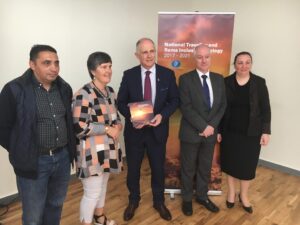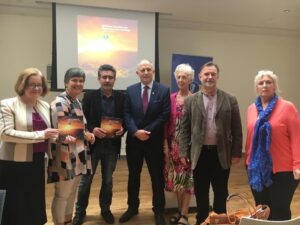Skip to content
Home » News » NEW TRAVELLER/ROMA STRATEGY – A ROADMAP TO POSITIVE CHANGE

Today’s publication of the new National Traveller Roma Inclusion Strategy (NTRIS) provides a much-needed roadmap for Traveller and Roma inclusion that outlines positive commitments across departments and agencies.
“The new Strategy reflects a partnership approach, demonstrated through the development of the NTRIS steering group and national consultations. We commend the work undertaken by the Department of Justice and Equality and Equality Minister, David Stanton, TD to lead and steer this process,” said Martin Collins, Co-Director, Pavee Point Traveller and Roma Centre.
“We now look forward to working in partnership with departments and agencies to ensure that the strategy has impact and positive outcomes in the lives of Roma and Travellers.

 “NTRIS, as a living document, can be developed into a plan that will transform the experience of Travellers and Roma in Irish society and address serious human rights issues facing our communities,” he said.
“NTRIS, as a living document, can be developed into a plan that will transform the experience of Travellers and Roma in Irish society and address serious human rights issues facing our communities,” he said.
In particular, we welcome some significant commitments by departments and agencies:
-
The Department of Justice and Equality commits to support and value Traveller culture, identity and heritage within Irish society.
-
The Department of Health and the HSE commit to an action plan to improve Traveller health
-
The Department of Health and the HSE commit to a community health project to improve Roma health.
Full commitment to Traveller and Roma inclusion requires all government departments to take the guidance of the European Commission. The Commission specifically made the following recommendation to Ireland in 2016:
“A mainstreamed approach is sufficient when outcomes are identical for all components of the target groups
When evidence shows a clear gap between the situation of Roma and Travellers versus the rest of society (e.g. regarding their health and housing situation), policies should be adjusted and specific measures should also be developed.”[1]
“Specific measures are particularly important for the area of education where only 13% of Traveller children complete secondary education in comparison with 92% of the general population,[2]” said Martin Collins.
“Safe and secure housing for Roma remains a major issue and still needs to be explicitly addressed in the Strategy,” said Ronnie Fay, Pavee Point Co Director.
“Roma families are facing homelessness and living in abandoned warehouses and unsafe buildings – the Department of Housing, Planning, Community and Local Government will need to take action to address these issues,” said Ms. Fay.
“With an independent review of the 1998 Traveller Accommodation Act included in NTRIS we look forward to a shift in approach that will see concrete improvements in living conditions of nearly 20% of the Traveller population in need of accommodation,” added Ms. Fay.

Background:
Ireland has developed a National Traveller Roma Inclusion Strategy on foot of the EU Framework for National Roma Integration Strategies up to 2020. The EU Framework document sets out a framework for addressing inequality faced by Roma (Roma in the Irish context refers to Irish Travellers and Roma) in the areas of education, health, accommodation and employment.
Ireland first developed a strategy in January 2012 which was heavily criticised by the European Commission in its annual assessment. In 2013 the European Commission deemed that Ireland had met just 4 out of 22 criteria.
More information on the EU framework for National Roma Integration Strategies – http://ec.europa.eu/justice/discrimination/roma/index_en.htm
 “NTRIS, as a living document, can be developed into a plan that will transform the experience of Travellers and Roma in Irish society and address serious human rights issues facing our communities,” he said.
“NTRIS, as a living document, can be developed into a plan that will transform the experience of Travellers and Roma in Irish society and address serious human rights issues facing our communities,” he said.


